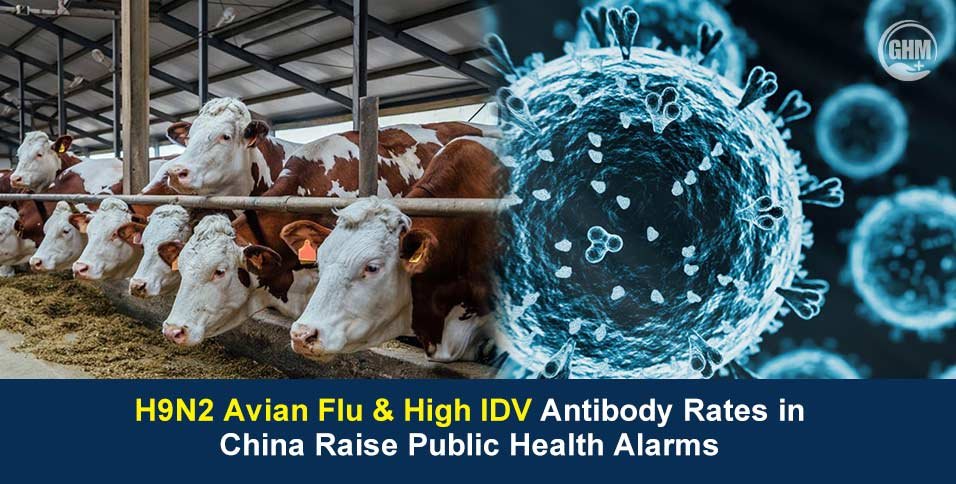Pandemic fears are once again in the spotlight as two new H9N2 avian flu cases were reported in China this week. While attention is focused on this new flu variant, public health experts are also warning about a less visible threat among farm workers. Silent exposure to cattle flu viruses, such as Influenza D Virus (IDV), as well.
High antibody rates were found in cattle workers. It suggests that many may have been infected without showing symptoms. It is a silent signal that zoonotic viruses (viruses that jump from animals to humans) could spread unnoticed.
Two New H9N2 Avian Flu Cases in China
Recent reports from Chinese health authorities confirmed two human infections with H9N2 avian flu. It is a low-pathogenic virus known to circulate widely in poultry. While most infections so far have been mild, health experts warn the virus has pandemic potential if it mutates to spread more easily between humans.
Why This Matters
- H9N2 avian flu has infected people in several countries, often linked to poultry markets.
- It has contributed genetic material to other dangerous flu viruses, including H5N1.
- Repeated exposure increases the chance of mutations that could make the virus more transmissible.
- These new cases in China come amid wider pandemic fears tied to evolving flu variants.
This resurgence has raised global alert levels, with the World Health Organisation and national agencies monitoring flu activity closely.
IDV Exposure in Cattle Workers
While the world’s attention is locked on the H9N2 avian flu, another virus, Influenza D (IDV), is quietly spreading among cattle herds and agricultural workers.
More than 90% of cattle workers were found to be positive in multiple studies from the U.S., China, and Europe. It means many have antibodies against IDV, indicating past exposure, even though a few showed symptoms.
A Silent Exposure
- Subclinical infections are cases where people get infected but show no obvious symptoms.
- These individuals may still shed the virus or contribute to an unnoticed spread.
- When a virus circulates silently, it can adapt and mutate without being detected.
This makes viruses like IDV a hidden public health concern, especially when they overlap with other flu threats like avian flu.
Why Farm and Animal Workers Are on the Frontline
Farmers, slaughterhouse employees, and animal handlers are among those who are most exposed to zoonotic flu viruses. In the case of IDV, cattle are the main host, but the virus has also been detected in pigs, goats, and even domestic pets like cats.
Risk Factors
- Daily, close contact with livestock
- Limited personal protective equipment (PPE) use in many settings
- Gaps in rural health surveillance systems
- Overlap with avian flu exposure in mixed farms
This One Health risk, where animal, human, and environmental health intersect, underscores why monitoring workers is a critical step in preventing future pandemics.
How H9N2 Avian Flu & IDV Threats Intersect
H9N2 avian flu and IDV are different viruses, one from birds, the other from cattle. But their overlapping presence in farm environments increases the risk of viral reassortment, where viruses mix genetic material.
Potential Public Health Implications
- H9N2 avian flu can spread through poultry contact and potentially evolve into a more dangerous strain.
- IDV exposure may remain undetected for years if not actively monitored.
- Workers exposed to multiple flu viruses could become “mixing vessels”, increasing mutation risk.
- Early surveillance could help catch new variants before they spread globally.
Surveillance Gaps and What Needs to Change
Despite growing awareness, IDV is not routinely included in most national or global influenza surveillance systems. This creates a dangerous blind spot.
Key Challenges
- Lack of standardised diagnostic testing for IDV in humans
- Limited data on human-to-human transmission potential
- Inadequate monitoring in high-risk regions
- Focus remains heavily on H5N1 and H9N2 avian flus, leaving cattle flu under the radar
Strengthening surveillance, especially in mixed animal farms and live markets, could help prevent the next big outbreak.
What Experts Are Calling For
Public health experts are urging a dual approach, tackling the immediate avian flu risk while not ignoring silent threats such as IDV.
Key Recommendations
- Include IDV in global influenza surveillance networks.
- Expand testing among high-risk groups (farmers, slaughterhouse workers).
- Promote stronger animal biosecurity measures.
- Develop candidate vaccines and antiviral strategies for IDV.
- Enhance early warning systems using One Health frameworks.
Conclusion
The H9N2 avian flu cases in China are a reminder that viral threats can emerge suddenly, but the real danger may also come from the ones we don’t see, like silent IDV exposure in cattle workers.
A stronger, broader strategy to prepare for a pandemic should address both immediate outbreaks and hidden transmission chains.
Monitoring farm workers, expanding diagnostic networks, and investing in early warning systems can help the world stay ahead of the next flu threat.


















